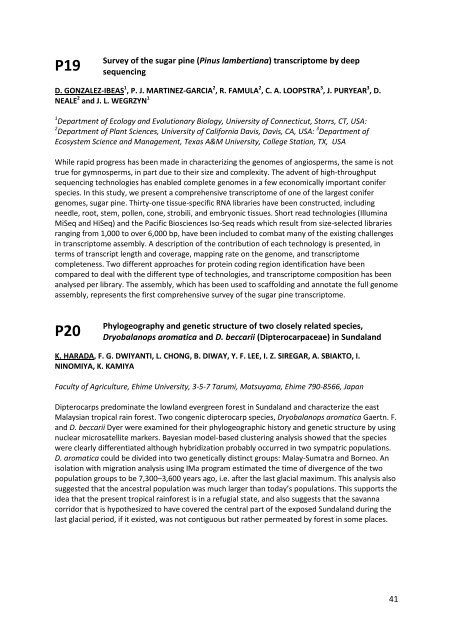You also want an ePaper? Increase the reach of your titles
YUMPU automatically turns print PDFs into web optimized ePapers that Google loves.
P19<br />
Survey of the sugar pine (Pinus lambertiana) transcriptome by deep<br />
sequencing<br />
D. GONZALEZ-IBEAS 1 , P. J. MARTINEZ-GARCIA 2 , R. FAMULA 2 , C. A. LOOPSTRA 3 , J. PURYEAR 3 , D.<br />
NEALE 2 and J. L. WEGRZYN 1<br />
1 Department of Ecology and Evolutionary Biology, University of Connecticut, Storrs, CT, USA:<br />
2 Department of Plant Sciences, University of California Davis, Davis, CA, USA: 3 Department of<br />
Ecosystem Science and Management, Texas A&M University, College Station, TX, USA<br />
While rapid progress has been made in characterizing the genomes of angiosperms, the same is not<br />
true for gymnosperms, in part due to their size and complexity. The advent of high-throughput<br />
sequencing technologies has enabled complete genomes in a few economically important conifer<br />
species. In this study, we present a comprehensive transcriptome of one of the largest conifer<br />
genomes, sugar pine. Thirty-one tissue-specific RNA libraries have been constructed, including<br />
needle, root, stem, pollen, cone, strobili, and embryonic tissues. Short read technologies (Illumina<br />
MiSeq and HiSeq) and the Pacific Biosciences Iso-Seq reads which result from size-selected libraries<br />
ranging from 1,000 to over 6,000 bp, have been included to combat many of the existing challenges<br />
in transcriptome assembly. A description of the contribution of each technology is presented, in<br />
terms of transcript length and coverage, mapping rate on the genome, and transcriptome<br />
completeness. Two different approaches for protein coding region identification have been<br />
compared to deal with the different type of technologies, and transcriptome composition has been<br />
analysed per library. The assembly, which has been used to scaffolding and annotate the full genome<br />
assembly, represents the first comprehensive survey of the sugar pine transcriptome.<br />
P20<br />
Phylogeography and genetic structure of two closely related species,<br />
Dryobalanops aromatica and D. beccarii (Dipterocarpaceae) in Sundaland<br />
K. HARADA, F. G. DWIYANTI, L. CHONG, B. DIWAY, Y. F. LEE, I. Z. SIREGAR, A. SBIAKTO, I.<br />
NINOMIYA, K. KAMIYA<br />
Faculty of Agriculture, Ehime University, 3-5-7 Tarumi, Matsuyama, Ehime 790-8566, Japan<br />
Dipterocarps predominate the lowland evergreen forest in Sundaland and characterize the east<br />
Malaysian tropical rain forest. Two congenic dipterocarp species, Dryobalanops aromatica Gaertn. F.<br />
and D. beccarii Dyer were examined for their phylogeographic history and genetic structure by using<br />
nuclear microsatellite markers. Bayesian model-based clustering analysis showed that the species<br />
were clearly differentiated although hybridization probably occurred in two sympatric populations.<br />
D. aromatica could be divided into two genetically distinct groups: Malay-Sumatra and Borneo. An<br />
isolation with migration analysis using IMa program estimated the time of divergence of the two<br />
population groups to be 7,300–3,600 years ago, i.e. after the last glacial maximum. This analysis also<br />
suggested that the ancestral population was much larger than today’s populations. This supports the<br />
idea that the present tropical rainforest is in a refugial state, and also suggests that the savanna<br />
corridor that is hypothesized to have covered the central part of the exposed Sundaland during the<br />
last glacial period, if it existed, was not contiguous but rather permeated by forest in some places.<br />
41



